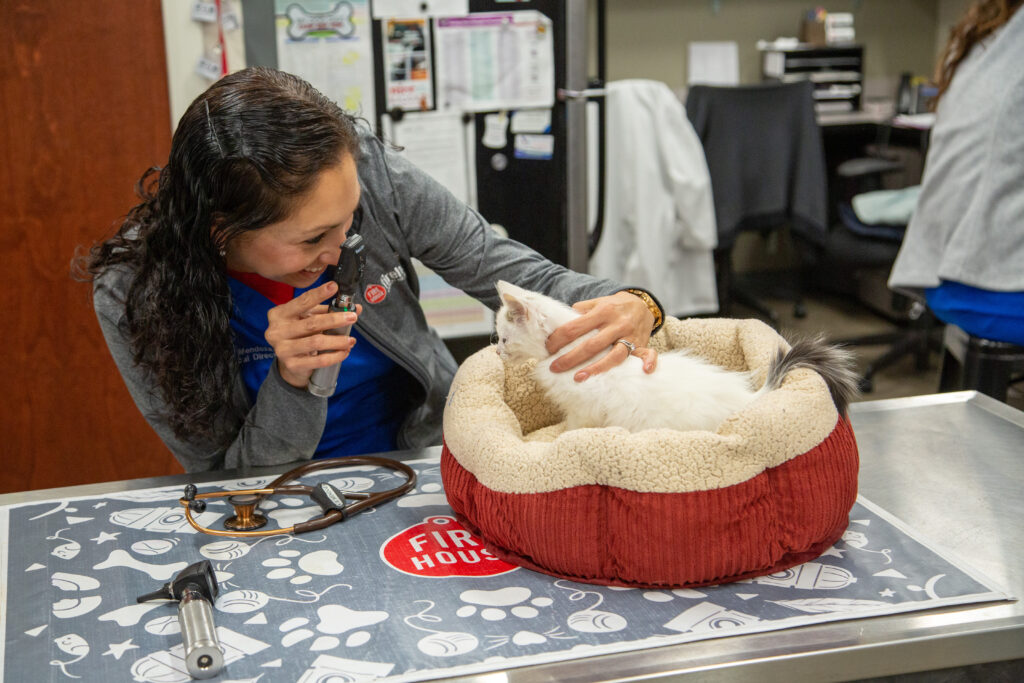7.5 min read

Dr Adriana Mendoza examines a patient at Firehouse Leander.
Luna’s unusual lethargy and unquenchable thirst worried her parents. Our team confirmed diabetes. We helped Luna’s family move her onto a controlled diet and insulin regimen. Her playful spirit has returned at home and when she visits Firehouse Leander.
Just like humans, pets can get diabetes. And just like us, it can be scary to hear that your pet might have a new disease.
Fortunately, our understanding of diabetes in animals grows each year. Treating pet diabetes in 2023 is much more effective than it was 30 years ago. We have new and better products, often offering our 4-legged friends a high quality of life alongside this disease.
Diabetes in pets is a medical condition where a dog or cat’s body has trouble handling sugar, one of the basic fuel sources for their bodies. This happens because they either don’t make enough of a substance called insulin or their bodies can’t process insulin.
2 new advancements for diabetes in pets
There are two new products that improve diabetes treatments in animals:
1. FreeStyle Libre 2 is not a medication, but a small monitor that attaches to your dog or cat’s skin.
So, instead of leaving your pet at the hospital for an all-day (and stressful) evaluation that can affect glucose levels, we’ll apply FreeStyle Libre to your pet’s skin and send them home for monitoring.
This way, we can watch your pet’s blood sugar levels for up to 14 days. Since your pet is at home, this monitor gives us much better data over a longer period of time about your dog or cat’s glucose (blood sugar) than if they were at a veterinary hospital.
An alarm sounds if your pet’s sugar levels are too low or too high. Together, we track your pet’s blood sugar to decide how much insulin to give. This can ebb and flow over time, so we like seeing detailed readings to give more exact doses.
In terms of cost, FreeStyle Libre is comparable to other ways of managing diabetes in pets.
2. Bexacat is an innovative medication because it’s a once-daily diabetes pill for cats. This is new!
Until now, parents gave their cats twice daily injections. This was often intimidating for cat owners.
We know many pet parents will be relieved that there is a new option on the market. A pill is a nice alternative to daily injections.
Unfortunately, Bexacat cannot be used in cats that have already been on injectable insulin.
Let’s talk about either of these new solutions if your pet has diabetes.
Next steps after diagnosis
Once a pet has been diagnosed with diabetes, we’ll help you with the next steps. We’ll have lots of conversations to make sure you and your pet are comfortable with the medication we recommend and the daily home process.
If you opt for daily insulin injections, we’ll show you how to administer them and monitor your pet’s blood sugar levels.
There isn’t a one-size-fits-all treatment for diabetes. So, we’ll keep in touch to ensure your pet’s diabetic symptoms are improving. We usually need to adjust each pet’s treatment regimen before we perfect it.
We’ll also make nutrition and exercise recommendations. Both are important parts of treatment.
Overall, successful management of diabetes requires regular exams at Firehouse. We also advise consistent blood and urine tests. Plus, we’ll monitor your pet’s weight, appetite, drinking, and urination.
General causes of diabetes in pets
“We mostly see diabetes related to being overweight in cats,” says Dr Emily McCann, Veterinarian at Firehouse Kyle. “Dogs seem to be genetically predisposed to diabetes.”
“Extra weight in cats is directly related to an increased risk of diabetes in cats,” Dr Spencer notes. “In dogs, diabetes tends to be more of a genetic disease, but it is much easier to control when dogs are at a lean body weight.”
General causes include:
–Genetics: As noted above, certain dog breeds are more prone to diabetes.
–Obesity: Overweight pets are at a higher risk of developing diabetes. Studies show that pets worldwide are carrying excess weight. For cats, this leads to diabetes. For dogs, it makes this disease harder to treat. Where does your pet stand? Check out this graphic to see if your pet is in the “ideal weight” category.
–Pancreatitis: Inflammation of the pancreas can lead to diabetes in pets.
–Age: Older pets are more likely to develop diabetes.
–Long term use of steroids: The extended use of medications containing steroids may also be a risk factor for diabetes.
Signs your pet might have diabetes
You might notice your pet drinking or urinating more. They might lose weight, even though they’re eating more. And they might seem tired or sluggish.
Here’s a complete list of diabetes symptoms in pets:
-Increased water consumption and urination: this is often one of the first signs of diabetes in pets.
-Weight loss: despite an increased appetite, pets may lose weight.
-Change in appetite
-Vomiting
-Chronic urinary tract and/or skin infections
-Lethargy: they may seem weak or tired.
-Cloudy eyes: this is a condition known as cataracts, which can be a result of unregulated diabetes.
If your pet is showing signs consistent with diabetes, we’ll perform a simple blood test to confirm the diagnosis. We might also conduct more blood tests to rule out other possible diseases.
This is one of the reasons we love to see pets each year for a check-up. An annual wellness exam allows us to visit about your pet’s behavior, their habits, and screen for possible disease based on what you’re seeing at home.
Prevention
It’s not always easy to prevent diabetes. As we’ve seen, a dog’s breed can make them predisposed to this disease.
Yet, we have some general tips:
-Don’t overfeed your pets. Save treats as a sometimes (not everyday) food.
-Know the symptoms so you can intervene early. The earlier the diagnosis, the better chance your pet may have for a longer and healthier life.
What else should we know?
If a pet’s diabetes isn’t looked after, it can lead to other problems.
Regular visits to the vet
We recommend regular rechecks, especially in the early stages of diagnosis. This helps us work with you and to get your pet on a regulated dose of insulin that best controls their symptoms and numbers.
Nutrition
Dogs and cats with diabetes usually require lifelong treatment with special diets. This includes (usually including high-fiber foods), daily exercise, and daily insulin injections.
Plus, pet owners should consider spaying female dogs diagnosed with diabetes.
With the right care, most pets with diabetes can live happy lives.
November is National Pet Diabetes Month. It’s a great time to learn about new treatments or know what to look out for.
If you suspect your pet might have diabetes, please call us to discuss next steps. We’re here to support you and your furry friend in navigating this challenge, so that cats and dogs can get back to enjoying life to the fullest.

